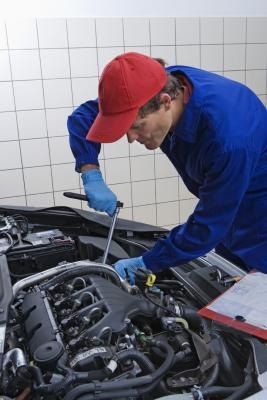The 22R engine has four cylinders and a displacement of 2.4 liters. Toyota manufactured this engine from 1981 to 1995, and it is the standard engine in Toyota Celicas made from 1981 to 1984. The 22R has a single cylinder head for all four cylinders, which forms part of the combustion chamber. The cylinder head gasket for the 22R engine lies between the cylinder head and the engine block.
1 Remove the cable from the negative battery terminal with a socket wrench. Disconnect the flange nuts from the exhaust pipe, and detach it from the exhaust manifold. Place a large container under the radiator drains, and drain the coolant from the cooling system into the container for reuse.
2 Disconnect the air cleaner from the carburetor with a socket wrench, including its hoses. Place a shop cloth over the carburetor to keep debris out of the engine. Disconnect any vacuum hoses and fuel lines as required to gain access to the cylinder head.
3 Record the positions for the electrical leads on the spark plugs, and detach them them from the spark plugs. Mark the distributor housing and engine block to ensure you can install the distributor in the correct position later. Disconnect the distributor assembly with a socket wrench. Remove the mounting nuts from the valve cover, and detach the valve cover. Detach the camshaft seals.
4 Turn the crankshaft clockwise to align its timing mark with the timing mark on the timing chain. Remove the mounting bolt for the camshaft sprocket with a socket wrench, and detach the distributor drive gear from the camshaft. Hold the camshaft sprocket in place with wire, and disconnect the cover for the timing chain from the cylinder head.
5 Remove the mounting bolts from the cylinder head with a socket wrench. Insert pry bars under the front and rear of the rocker arm assembly, and pry it off the mounting dowels. Lift the cylinder head from the engine block, and drain the oil from the crankcase to avoid contaminating the oil with coolant.
6 Remove the old gasket from the engine block, and apply liquid sealer to the gasket mounting surface on the block. Place a new cylinder head gasket on the engine block, and mount the cylinder head to the dowels.
7 Turn the camshaft clockwise until its timing pin points straight up. Remove the wire holding the camshaft sprocket in place, and turn the crankshaft until the hole in the camshaft sprocket points straight up. Hold the camshaft sprocket in place with the length of wire. Mount the rocker arm assembly over the dowels on the engine block.
8 Tighten the mounting bolts to the cylinder head in three separate passes with a torque wrench. The final torque on the mounting bolts must be between 52 and 63 foot-pounds. Replace the timing chain cover, and tighten its mounting bolt to between 7 and 11 foot-pounds.
9 Remove the wire holding the camshaft sprocket in place, and mount the sprocket to the dowel on the camshaft. Mount the drive gear for the distributor to the crankshaft, and tighten the mounting bolt for the crankshaft to between 51 and 65 foot-pounds with a torque wrench.
10 Turn the crankshaft clockwise to align its timing marks, and adjust the valve clearance. Turn the crankshaft 352 degrees clockwise to align the Before Top Dead Center mark on the crankshaft pulley with the timing mark on the crankshaft.
11 Install the distributor and spark plugs, using the marks you made in Step Three as a guide. Install the seals for the camshaft, and replace the engine oil. Lubricate the distributor drive gear and valve rockers with clean engine oil. Replace the valve cover, and tighten its mounting bolts to between 8 and 11 foot-pounds with a torque wrench.
12 Connect all electrical wiring and vacuum hoses you removed to access the cylinder heads. Replace the coolant in the cooling system, and connect the air cleaner to the carburetor with a socket wrench. Connect the exhaust pipes to the exhaust manifold, and tighten the flange bolts to between 25 and 33 foot-pounds with a torque wrench.
13 Connect the cable to the negative battery terminal with a socket wrench, and start the engine. Wait for the engine to reach its operating temperature, and adjust the timing, idle speed and fuel mixture.




























